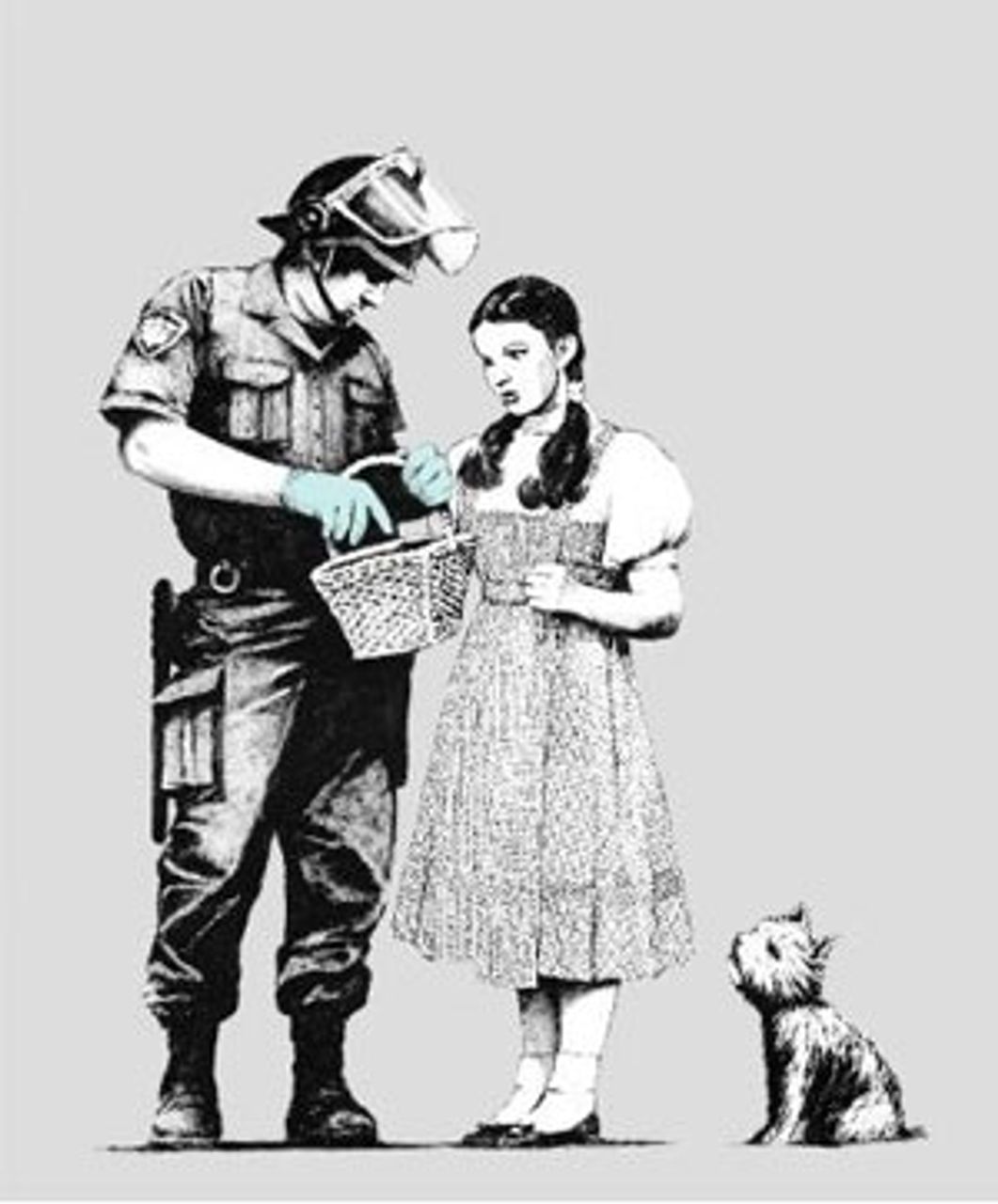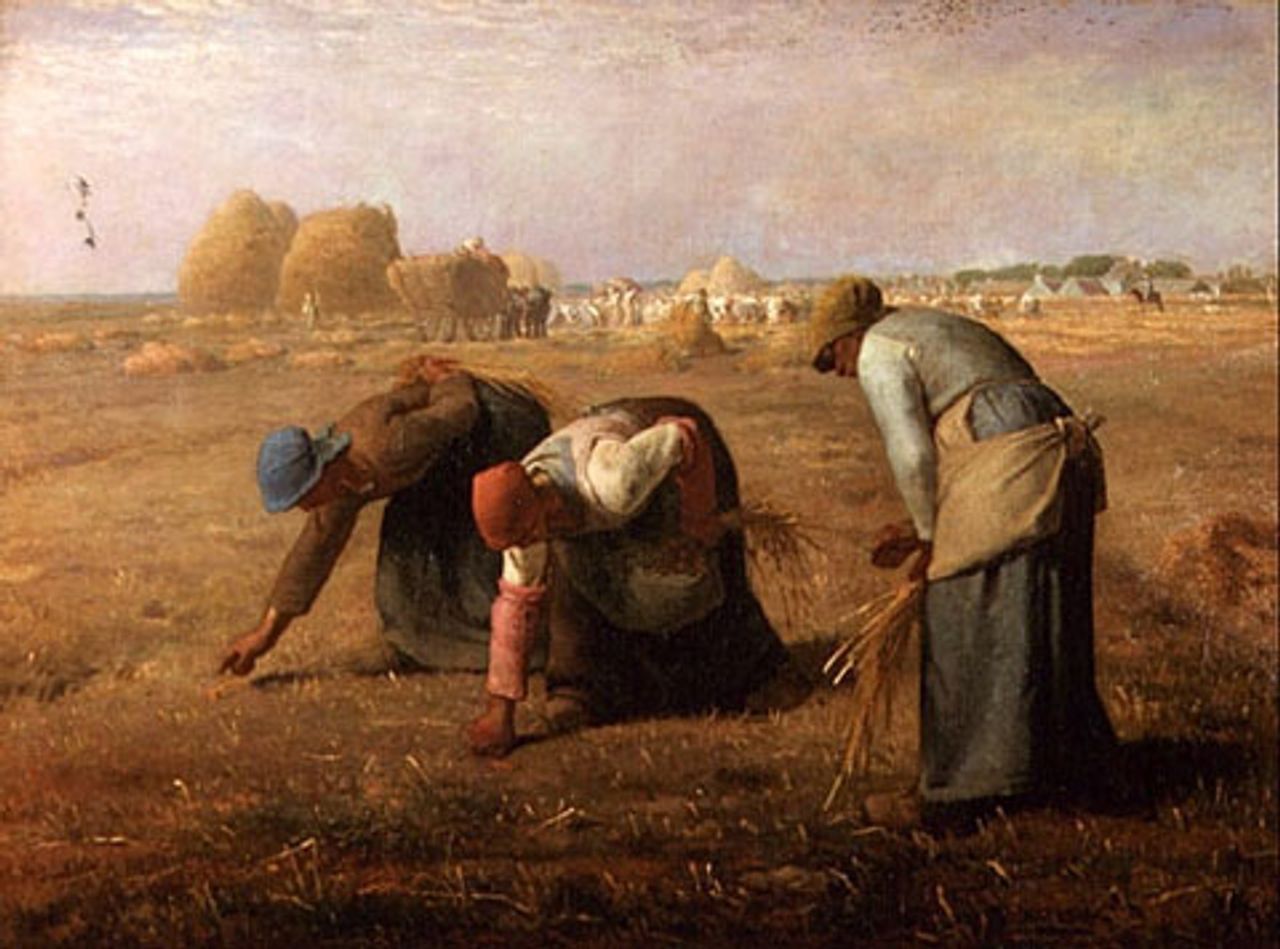Over 300,000 people saw the exhibition of works by “guerilla” graffiti artist Banksy at Bristol museum and art gallery this summer. The number of visitors, queuing for up to six hours, approached the total population of the city in the west of England.
 “Stop and Search” by Banksy.
“Stop and Search” by Banksy. Courtesy Banksky.co.uk
Banksy has undergone a meteoric rise to fame. His unknown identity and nocturnal spray-painting activities have all added to the mystique surrounding him. The city’s chief executive Jan Ormondroyd said, “It has probably been the most successful exhibition in the UK. It is more than any of us expected, certainly in terms of putting Bristol on the map. We have to say a big thank-you to Banksy.”
There is a social conscience evidenced in Banksy’s work and a certain dry wit, but there are limitations of both an aesthetic and political character.
Visitors entering the Bristol Museum’s palatial entrance hall were confronted by a burnt out ice cream van playing its plaintive melody. Behind it a life-size Metropolitan policeman wearing a “Metropolitan Peace” badge creaked to and fro on a fairground horse. Close by a classical statue adorned with shopping bags and sunglasses contrasted with her neighbour covered in a ragged blanket—a dog and broken bicycle at her feet.
In a second room, stencils, paint cans and other tools of the trade littered one corner, while right wing radio show hosts ranted over a loudspeaker about graffiti defacing private property. Britannia, the symbol of British imperialism, held her spear topped by a CCTV camera. Riot police ran through the grass holding hands and smelling flowers. An African child with a sign said, “Peaches Geldof, please give generously.”
Further along, copies of old master portraits sported beady eyes or a plastic nose. A beautiful mountain landscape was captioned with the words “Subject to availability for a limited period only.” At the far end of the room hung a huge House of Commons canvas, with Members of Parliament replaced by chimpanzees.
In a darkened third room named “Unnatural History,” cages had been constructed containing lifelike animatronic figures. A hen looked out of her coop at her offspring—chicken nuggets—pecking at a sachet of ketchup, a rabbit preened herself in front of a mirror and a balding Tweety Pie blinked forlornly on his perch.
Elsewhere in the museum various objects such as a muzzled woolly lamb lay hidden amongst the stuffed animals and scientific specimens. In the art gallery hung copies of well-known paintings, defaced in some way.
A video of Banksy installing the exhibition can be viewed on a YouTube video.
Banksy’s surreal and satirical graffiti work has appeared in numerous locations around the world, addressing topics such as war, the power of the state and corporations, environmental degradation and animal rights. Many municipal authorities who once rushed to scrub off what they ridiculed as vandalistic rubbish are having second thoughts as the prices of his works skyrocket.
Banksy’s graffiti first began appearing in the UK in the 1990s. He admits he used stencils because “spray paint’s actually quite hard to use… and I found myself painting embarrassingly bad pictures, illegally on a wall, at 21 years old.”
He claims, “I got politicised during the poll tax, the Criminal Justice Act and the Hartcliffe Riots—that was Bristol’s Rodney King. I can also remember my old man taking me down to see the Lloyds bank—what was left of it—after the 1980 St. Pauls riots.”
Banksy began to produce “subverted paintings” such as Monet’s Water Lily Pond—with its superimposed shopping trolley and traffic cone.
In the Paris Louvre he pinned up a copy of the Mona Lisa adding a yellow smiley face. Similar pranks followed in London’s Tate Modern, New York’s Museum of Modern Art and other institutions.
In 2005, Banksy went to Israel and painted on the security barrier dividing the West Bank. His images included a girl floating over the wall holding onto balloons and children digging through it to reveal a tropical beach on the other side.
“How illegal is it to vandalize a wall?” Banksy asked his critics.
“The Israeli government is building a wall surrounding the occupied Palestinian territories. It stands three times the height of the Berlin wall and will eventually run for over 700km—the distance from London to Zurich. The International Court of Justice last year ruled the wall and its associated regime is illegal. It essentially turns Palestine into the world’s largest open-air prison.”
In 2006, Banksy smuggled an inflatable orange suited doll representing a Guantanamo Bay detainee into the California Disneyland theme park. The following year he painted the Jackson and Travolta characters from Quentin Tarantino’s “Pulp Fiction” above a London Tube station, substituting bananas for their guns. Transport for London ordered its removal, saying it created “a general atmosphere of neglect and social decay which in turn encourages crime.”
In 2008, Banksy marked the third anniversary of the Hurricane Katrina disaster by producing a series of graffiti works on derelict buildings in New Orleans.
As Banksy’s fame spread so did the price tag on his works. When his “Space Girl and Bird” sold for $576,000 he posted a painting on his web site of an art auction with the words, “I can’t believe you morons actually buy this shit.”
Last year Banksy’s pastiche of a Damien Hirst spot painting “Keep It Spotless,” showing a Condoleezza Rice figure sweeping dirt “under the carpet,” sold for nearly £1 million.
Unlike most of his contemporaries Banksy points to real issues that resonate with wide layers of the population. He calls the art world “the biggest joke going ... a rest home for the overprivileged, the pretentious, and the weak.”
However, the simple iconoclastic images and one-liner jokes that often accompany them, while offering an angry and healthy protest, are also informed by a certain resigned cynicism. In his book Wall and Piece he writes, “We can’t do anything to change the world until capitalism crumbles. In the meantime we should all go shopping to console ourselves.”
Elsewhere he says, “To make a piece of art that actually provoked something serious to happen? I couldn’t even dream of that ... but yeah ... I guess that’s the aim.”
This is all pretty passive stuff.
Why reject a priori what Banksy acknowledges should be one of art’s highest aims?
In a corner of the Bristol exhibition, Banksy took a copy of Millet’s 1857 painting “The Gleaners,” renamed it “Agency Job,” cutting out one of the three peasant women labouring in the fields and placing her on the frame smoking a cigarette.
 “The Gleaners” by Millet
“The Gleaners” by MilletMillet had been deeply affected by the 1848 revolutions and their promise of democracy. He became the first European painter to portray the peasantry, a doomed class impoverished by advancing capitalism, in such a sympathetic and noble manner. His calm imagery, which declares, “Yes, the world can be changed into a better place,” was castigated by bourgeois society and taken up by the emerging socialist movement.
Banksy texted the media regarding his exhibition, “It’s nice to see it’s been so popular but it makes me a bit suspicious. Throughout history all the great artists have been overlooked in their own lifetime and only appreciated once they’ve gone. I’m starting to worry I’m not one of the good guys.”
It is right and proper to ask such questions of oneself and one’s work. For something “serious to happen,” which Banksy and any artist should aspire to, then a serious (not humourless) approach to art is required. Whether Banksy’s work progresses in that direction or whether he is merely co-opted to become another bad boy for the art establishment is yet to be decided.
